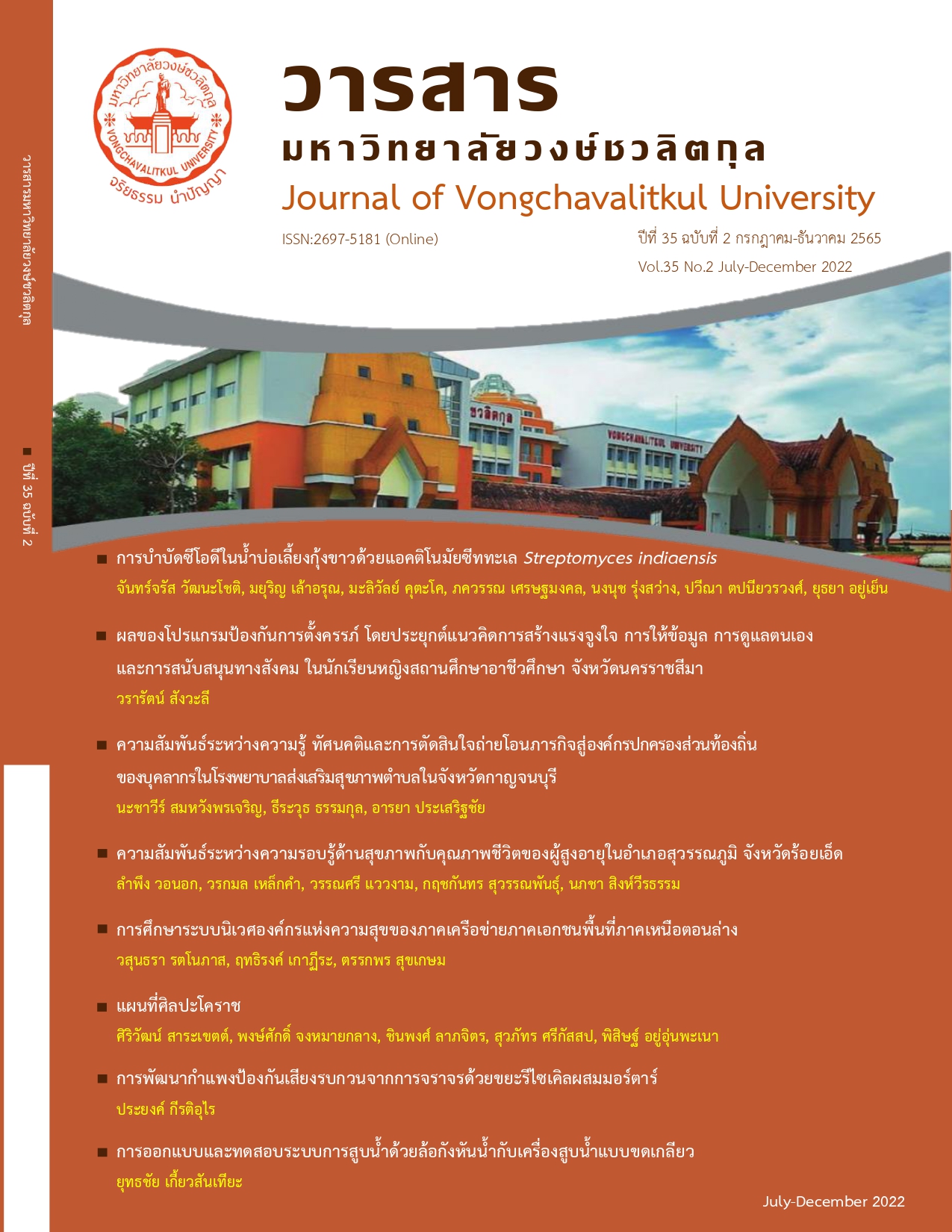Development of Traffic Noise Barrier by Recycle Waste with Mortar
Main Article Content
Abstract
Objectives: This research aimed to study the efficiency of soundproofing and the compressive strength, flexural strength and tensile strength of the traffic noise barrier by recycle waste with mortar.
Methods: The traffic noise barriers by recycle waste were 1 meter wide, 1 meter long and 15 centimeters thick. Recycled wastes were used in the study that were styrofoam food packaging and paper egg cartons. They were mixed as the each of soundproofing materials at the mixing percentages were 0, 10, 25 and 50 by weight. Tile adhesive cement was the bonding agent in w/c ratio as 0.7.
Results: The higher the amount of recycled waste in the noise barrier, the soundproof performance of the noise barrier plates were also higher. The noise barrier plates were mixed with the recycled waste as styrofoam food packaging. They were more efficiency in the soundproofing than paper egg cartons. In addition, the noise barrier plates mixed with 50% of recycled waste as styrofoam food packaging had higher soundproofing efficiency than the soundproof mortar wall plates. They hadn't the recycled wastes. And the results of the studies on the compressive strength, flexural strength and tensile strength of the noise barrier plates that were mixed with soundproofing materials from recycled wastes. They were the noise barrier plates mixed with 50% by weight of recycled waste as styrofoam food packaging would have the minimum compressive strength, the minimum flexural strength and the minimum tensile strength were 27.267 kg/cm2, 11.410 kg/cm2 and 2.526 kg/cm2, respectively. That the compressive strength, the flexural strength and the tensile strength of the traffic noise barrier by recycle wastes with mortar were higher than the highway department standards. But there must also be reinforcement of the bending steel and the tensile steel in the soundproof mortar walls. In order to prevent accident cases that they were cause of the mortar wall plate to break and fall. And they have made to damage and danger with the road users.
Article Details

This work is licensed under a Creative Commons Attribution-NonCommercial-NoDerivatives 4.0 International License.
References
กรมทางหลวง. (2558). STANDARD DRAWING FOR HIGHWAY DESIGN AND CONSTRUCTION. กระทรวงคมนาคม.
กรมควบคุมมลพิษ. (2558). คู่มือการตรวจวัดระดับเสียงของรถยนต์. ส่วนมลพิษทางเสียงและความสั่นสะเทือน สำนักจัดการคุณภาพอากาศและเสียง กรุงเทพมหานคร. กรมควบคุมมลพิษ กระทรวงทรัพยากรธรรมชาติและสิ่งแวดล้อม.
กรมควบคุมมลพิษ. (2562). รายงานสถานการณ์มลพิษของประเทศไทย ปี 2561. กรุงเทพมหานคร. กรมควบคุมมลพิษ กระทรวงทรัพยากรธรรมชาติและสิ่งแวดล้อม.
เกษม จันทร์แก้ว. (2541). เทคโนโลยีสิ่งแวดล้อม. โครงการสหวิทยาการบัณฑิตศึกษา สาขาวิชาวิทยาศาสตร์สิ่งแวดล้อม: มหาวิทยาลัยเกษตรศาสตร์.
ธรรมธร ไกรก่อกิจ. (2562). ค่า STC คืออะไร. สืบค้นเมื่อ 17 กุมภาพันธ์ 2565, จากเว็บไซต์: https://www.zen- acoustic.com/what-is-stc.html
บุรฉัตร วิริยะ. (2544). การศึกษาเปรียบเทียบประสิทธิภาพการดูดซับเสียงของวัสดุพืชแห้งและเส้นใยแก้ว. วิทยานิพนธ์ปริญญาวิศวกรรมศาสตรมหาบัณฑิต สาขาวิชาวิศวกรรมสิ่งแวดล้อม. มหาวิทยาลัยเทคโนโลยีสุรนารี.
บุรฉัตร วิริยะ. (2551). การศึกษาและพัฒนาวัสดุป้องกันเสียงที่ผลิตจากของเสียอุตสาหกรรมที่มีสารบิทูเมนเป็นองค์ประกอบเพื่อลดระดับเสียงรบกวนจากการจราจร. วิทยานิพนธ์ปริญญาวิศวกรรมศาสตรดุษฎีบัณฑิต. สาขาวิชาวิศวกรรมสิ่งแวดล้อม มหาวิทยาลัยเทคโนโลยีสุรนารี.
ประธาน อารีพล. (2541). การจัดการมลพิษทางเสียง และความสั่นสะเทือน. อ้างถึงใน พวงแก้ว กิจกรรม และคณะ, 2538 ปราณี ชวลิตกุลชัย และคณะ, 2527. นนทบุรี: บริษัท เอ็นไวร์ คอนเซ็ป จำกัด.
พิพัฒน์ ละอองศรี. (2556). การประเมินประสิทธิภาพของกำแพงกั้นเสียงตามแนวทางหลวงพิเศษ หมายเลข 9 ตามสภาพปัจจุบัน. โครงงานปริญญาวิศวกรรมศาสตรมหาบัณฑิต การบริหารงานก่อสร้างและสาธารณูปโภค. สาขาวิชาวิศวกรรมโยธา สำนักวิชาวิศวกรรมศาสตร์. มหาวิทยาลัยเทคโนโลยีสุรนารี.
วิโรจน์ เชาว์จิพันธุ์. (2537). การศึกษาประสิทธิภาพของอุปกรณ์ลดเสียงในเครื่องจักรนิวแมติคโดยใช้วัสดุป้องกันเสียงที่หาได้ง่ายในท้องถิ่น. วิทยานิพนธ์ปริญญามหาบัณฑิต สาขาสุขศาสตร์อุตสาหกรรมและความปลอดภัย มหาวิทยาลัยมหิดล.
ศักดิ์ชัย อมรศักดิ์ชัย. (2541). การศึกษาประสิทธิภาพในการลดเสียงของวัสดุเหลือใช้ เมื่อใช้ซีเมนต์เป็นสารเชื่อมประสาน. วิทยานิพนธ์ปริญญามหาบัณฑิต สาขาเทคโนโลยีสิ่งแวดล้อมมหาวิทยาลัยมหิดล.
American Institute of Physics and Acoustical Society of America. (1997). Standard Test Method for Measurement of Airborne Sound Insulation in Buildings. ASTM E336-97. USA.
American Society for Testing and Materials. (1998). Annual Book of ASTM Standards: Sound Absorption and Sound Absorption Coefficients by the Reverberation Room Method: C423-90a. Volume 4.06. New York: Clearance Center.
American Society for Testing and Materials. (1998). Annual Book of ASTM Standards. Laboratory Measurement of Airborne Sound Transmission Loss of Building Partitions and Elements: E90-97. Volume 4.02. New York: Clearance Center.
American Society for Testing and Materials. (2011). Annual Book of ASTM Standards. ASTM C78 Standard test method for flexural strength of concrete (using simple beam with third-point loading). Volume 4.02. West Conshohocken, PA, USA: ASTM International.
American Society for Testing and Materials. (2017). Annual Book of ASTM Standards. ASTM C496 Test method for splitting tensile strength of cylindrical concrete specimens. West Conshohocken, PA, USA: ASTM International.
American Society for Testing and Materials. (2018). Annual Book of ASTM Standards. ASTM C39 Test method for compressive strength of cylindrical concrete specimens. West Conshohocken, PA, USA: ASTM International.
Cowan, J. P. (1994). Handbook of Environmental Acoustics. Van Nostrand Reinhold: International Thomson Publishing Company.
Harmelink, M. D. (1970). Noise and Vibration Control for Transportation System. D.H.O. Report No. RR 168, Canada: Ontario Department of Highways.
Lewis, H. Bell and Douglas, H. Bell. (1994). Industrial Noise Control. 2nd ed. New York. Marcel Dekker, Inc.
Thumann, A. and Miller, RM. (1986). Fundamental of noise control engineering. Georgia: Fairmont Press.
Welch, B. L. (1970). Physiological Effects of Noise. New York-London: Plenum Press.


